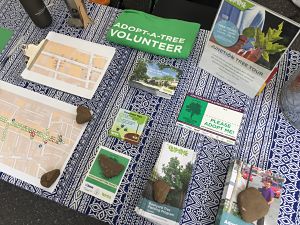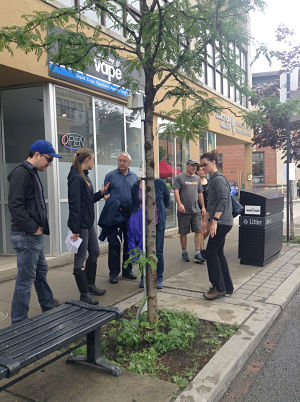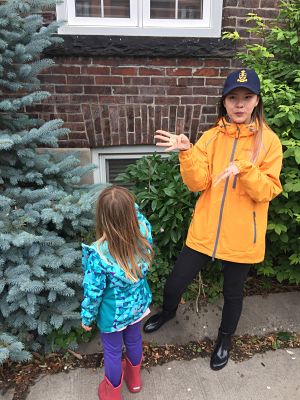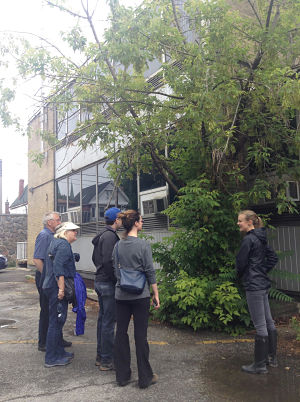Firstly, we were promoting and recruiting adopters for our Junction Adopt-a-Street-Tree (AAST) Program. There are currently 117 out of 137 trees adopted, and this number just keeps growing. We were thrilled to receive nothing but positive feedback about the AAST program and what it aims to accomplish, namely to engage the community in caring for the trees that enhance their local urban streetscape.

Our display booth at the Summer Solstice Festival. Visitors learned all about the Adopt-a-Street-Tree program, and some even signed up to adopt a tree of their own!
Our second goal was to offer festival-goers information about species identification and urban tree stressors through two tree tours. These tree tours were a fantastic way to connect local residents to the trees in their neighborhood. We looked at a variety of species, what they contribute, and the challenges that they must overcome in an urban setting.

The first stop of our tree tour on Dundas Street West- a honey locust that’s been adopted in the Junction AAST Program.
We opened the tour with an introduction to the Junction AAST program. It’s in its second year of operation, and has become well known in the neighborhood largely due to the small signs in the tree beds. These signs indicate the species and who has adopted the tree, or that the tree is looking for an adopter.
On this first stop, we also introduced the honey locust tree. It’s a common street tree due to its resilience to drought and urban air pollution, and casts a beautiful, light shade.

Lam giving the group a tip for identifying spruce trees!
Throughout the tour, we offered attendees tips to identify different trees in the city. Lam (LEAF’s Planting Program Assistant who co-lead the tree tour) talked about the “4 S” trick when identifying a spruce tree, such as the Blue Spruce pictured above. Needles on a spruce are “sharp, short, square, and single.” This was the only coniferous tree that we stopped at on our tour, although it sparked some interesting discussion about identifying other coniferous trees. For example, a handy way to identify a white pine is to remember that the word “white” has five letters, and it also has 5 needles in each bundle!

Looking at a couple of species that have managed to grow in not so ideal conditions.
Our last tree tour stop was tucked away in a parking lot. In this harsh environment, it certainly doesn’t seem like a tree would be able to survive (never mind thrive!) but this is not the case for the Manitoba maple and tree of heaven, pictured above. These fast growing species can shoot up in the harshest of environments. However, since they are fast growing they also have weak branches, rendering them very susceptible to damage in wind or snow storms. This susceptibility can lead to safety concerns and high clean-up costs after a storm, so they are much less desired species in the city.
To learn more about LEAF’s Adopt-a-Street-Tree program, check out our web page or take a look at our Adopt-a-Street-Tree Manual. And to get involved as an adopter or volunteer with the Junction Adopt-a-Street-Tree program, email junctiontrees[at]gmail.com.
Natalie is LEAF’s Volunteer and Stewardship Intern.
Photographs by Natalie Secen and Lam Tran.
